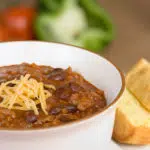When the weather cools down and the campfire gets going, there’s no better comfort food than chili to warm your soul and make it a perfect night. Every October, when autumn starts to chill our bones, break out the bread bowls and warm up with National Chili Month. Though its origins are murky, one thing we know is that chili doesn’t come from Mexico. Wherever it was created, this warm and filling Southwestern staple has become a beloved American dish and cultural touchstone, with festivals and cook-offs dedicated to the many varieties of chili.
History of National Chili Month
From cowboys to Girl Scouts, everyone who goes on camping trips has experienced the culinary delight that is chili con carne, also known simply as chili. Named for the spicy peppers that are its key ingredient, this simple, hearty, and delicious Southwestern staple has achieved cult status in the United States.First prepared somewhere in Southern Texas or Northern Mexico, chili started out as a simple preparation of meat and spices. Working-class women stewed beef pieces, chilis, and other vegetables and spices to make a hearty dish that would feed a whole family.In San Antonio, women known as “chili queens” made and sold chili by the bowlful in the city’s markets. Soon “chili parlors” began popping up, and the practice spread throughout Texas and other states, with each chili parlor claiming its own special, secret recipe. In the days before widespread home refrigeration you could purchase “brick chili,” a dehydrated version of the stew that kept longer and could be cooked with some water.In 1893, the San Antonio chili stand became an exhibit at the Columbian Exposition in Chicago, showcasing the humble “bowl o’ red” to the nation and popularizing chili across the Midwest.At its core, chili is just a seasoned stew of beef and chili peppers, topped with cheese and onions. But don’t be fooled — this deceptively simple dish sparks heated debates over what ingredients truly belong there. The only ingredients people can agree on are chilis and beef — the rest is up for debate. Even though beans seem like a natural addition, some chili connoisseurs swear beans have no place there at all.Today, chili remains a popular part of American cuisine and a ubiquitous camping food. You can find dozens of varieties including beef, bean-less, vegetarian, and turkey to suit your tastes.
National Chili Month timeline
In 1977, the Texas legislature proclaimed chili the official state food of the Lone Star State.
The first recipe for Frito Pie makes an appearance in a cookbook, revolutionizing the way kids across the southwest eat chili.
Women nicknamed “Chili Queens” start selling chili for 10 cents a bowl at stands in San Antonio’s markets.
J.C. Clopper wrote of a recipe that included meat hash "with nearly as many peppers as there are pieces of meat ... all stewed together.
National Chili Month FAQs
Is there a “real” chili recipe?
There are as many ways to prepare chili as there are chili cooks — and that’s not new. Since the days of chili parlors, each establishment has claimed its own secret recipe and special ingredients.
Where does the word “chili” come from?
“Chili” is originally a Nahuatl word meaning “hot pepper.” It was adopted by the Spanish and passed on through Texan and Southwestern cooking.
What makes chili peppers hot?
The heat in chiles comes from capsaicin, a compound found only in chile pepper plants. A pepper has the highest concentration of capsaicin in the placenta right below the stem, so be sure to remove this part from your peppers for less of a kick.
National Chili Month Activities
-
Make your own chili
Try your hand at cooking up a batch of classic chili, or see how creative you can get with new flavors and ingredients.
-
Attend a chili cook-off
Find a chili cook-off in your community and attend. It’s a fun way to spend time with family, sample interesting chili flavors, and get ideas for your own recipes.
-
Volunteer to host a chili night
Most soup kitchens let volunteers host meals. Get a group of friends together and host a chili night at your local soup kitchen. It’ll be a heartwarming treat for you and those in need.
5 Fascinating Facts About Chili
-
The Chili Queens started way back
San Antonio's Chili Queens may have started their chili cart enterprises as early as the 1810s.
-
The taco trucks of the 1800s
Common in Houston and Galveston as well as San Antonio, the chili queens' carts were the mobile food trucks of their day, serving laborers with cheap, hearty, and quick meals.
-
Celebrity chefs
In the 1920s and beyond, the Chili Queens gained legendary fame nationwide as tough, entrepreneurial, alluring women who kept their rowdier customers in check with a firm hand.
-
Regulations lead to downfall
By the 1940s, food safety regulations and urban development pushed vendors indoors and dispelled the unique charm of the Chili Queens.
-
Chili" can mean almost anything
The original Chili Queens served many dishes including enchiladas, tamales, and other indigenous Mexican and Tejano dishes. Because they all heavily relied on chili peppers for their distinctive flavor, "chili" became a popular term among English speakers who found it easy to pronounce.
Why We Love National Chili Month
-
It has so many varieties
You can spend days debating what the best chili ingredients are, and what’s more authentic. Better yet, you can spend that time sampling them for yourself! There are so many varieties to try, you’ll never get bored.
-
Chili cook-offs are fun
Chili cook-offs are a fun and wholesome way to spend time with family and friends, sample some delicious food, and gain some knowledge about cooking chili.
-
It’s easy and affordable to make
Many chili ingredients are cheap, easily available, and long-lasting. Make a big batch and freeze leftover chili in small containers so you have some ready to eat later on.
National Chili Month dates
| Year | Date | Day |
|---|---|---|
| 2023 | October 1 | Sunday |
| 2024 | October 1 | Tuesday |
| 2025 | October 1 | Wednesday |
| 2026 | October 1 | Thursday |
| 2027 | October 1 | Friday |





































































































































